Using Cellular Automata Approach to Optimize the Hydropower Reservoir Operation of Folsom Dam
Abstract
:1. Introduction
- Different optimization research studies [26,27] or commonly used simulation models for planners (e.g., CalSim II [28]) have employed the LP/DP and piecewise linearization methods to simplify the simulation of reservoir systems. However, linear programing often disregards the nonlinear and unsmooth representation of reservoir operation optimization problems, which leads to large errors in the optimization process [29]. One of the largest errors in these problems appears by linearization of the hydropower generation and the reservoir’s elevation–storage relationship nonlinearity [30]. Here, polynomial functions are used to express the hydropower generation equation and bathymetry (elevation-area-storage relationship) of the reservoir, rather than using the traditional piecewise linearization method.
- There are drawbacks associated with the classic optimization methods in order to solve large scale nonlinear optimization problems. In confronting the shortcomings of classical optimization methods, evolutionary algorithms (EAs) have been used to solve water resources management problems. Genetic algorithms (GAs) [3,31], particle swarm optimization (PSO) [32,33], ant colony optimization (ACO) [34,35], invasive weed optimization [36], and genetic programming (GP) [37] have been extensively used for the optimal operation of hydropower reservoirs. Different studies have investigated the application of EAs for discontinuous, non-differentiable, and non-convex problems. However, EAs are not able to converge for large problems, or often converge to a near-global optimal solution for many types of problems. These methods need extensive processing times to converge to a solution and are unable to exploit the entire decision variable space.
2. Methods
2.1. Mathematical Formulation
- Mass balance equation for the reservoir:where St, Qt, Rt, Lt and Spillt are storage of the reservoir, inflow to the reservoir, the released water from the reservoir, evaporation losses, and spill from reservoir, all at period t, respectively. Evaporation losses are calculated based on monthly evaporation rate in cm multiplied by the variable monthly surface area of the reservoir with respect to the simulated storage in time step t.
- Physical Constraints:where Smin is the minimum reservoir capacity based on the engineering design of the dam; is the minimum water release; and is the maximum water release from the reservoir, all in million cubic meters (MCM).
- Top of Conservation Level:The flood control purpose of the operation is considered through the satisfaction of these constraints. According to the existing rule curve, the capacity related to the top of the conservation level is taken as the maximum possible reservoir storage at period t, , and it varies with time.
- Power Equation:where g is gravity acceleration equal to 9.81 m/s2; η is the efficiency of the hydroelectric plant; Pf is the plant capacity factor (actual electrical energy output over a given period of time to the maximum possible electrical energy output over that period); and ht is the effective head of the hydropower plant in meter during time t, which is calculated aswhere Ht and TWLt are the elevation of water in the reservoir and downstream water elevation of the hydroelectric plant at period t, respectively.
- Bathymetry:The relationship between storage volume and water elevation is indicated by Equation (8). Additionally, Equation (9) represents the tailwater elevation based on downstream discharge (cms), Dt. The constant coefficients a1, a2, a3, a4, b1, b2, b3, and b4 are obtained by fitting the above equations into the available data.
2.2. Optimization Approach—Cellular Automata (CeA)
3. Case Study: Folsom Reservoir
4. Results
4.1. Hydroclimate Scenarios
4.2. CeA Optimization Results
5. Summary and Conclusions
Author Contributions
Funding
Institutional Review Board Statement
Informed Consent Statement
Data Availability Statement
Acknowledgments
Conflicts of Interest
References
- IEA. Medium-Term Renewable Energy Market. Report 2015; OECD/IEA: Paris, France, 2015. [Google Scholar]
- Barros, M.T.; Tsai, F.T.; Yang, S.L.; Lopes, J.E.; Yeh, W.W. Optimization of large-scale hydropower system operations. J. Water Resour. Plan. Manag. 2003, 129, 178–188. [Google Scholar] [CrossRef]
- Cheng, C.-T.; Wang, W.-C.; Xu, D.-M.; Chau, K.W. Optimizing hydropower reservoir operation using hybrid genetic algorithm and chaos. Water Resour. Manag. 2008, 22, 895–909. [Google Scholar] [CrossRef] [Green Version]
- Yurtal, R.; Seckin, G.; Ardiclioglu, G. Hydropower optimization for the lower Seyhan system in Turkey using dynamic programming. Water Int. 2005, 30, 522–529. [Google Scholar] [CrossRef]
- Olivares, M.A.; Lund, J.R. Representing energy price variability in long-and medium-term hydropower optimization. J. Water Resour. Plan. Manag. 2011, 138, 606–613. [Google Scholar] [CrossRef]
- Li, F.-F.; Shoemaker, C.A.; Wei, J.-H.; Fu, X.-D. Estimating maximal annual energy given heterogeneous hydropower generating units with application to the three gorges system. J. Water Resour. Plan. Manag. 2013, 139, 265–276. [Google Scholar] [CrossRef]
- Côté, P.; Leconte, R. Comparison of stochastic optimization algorithms for hydropower reservoir operation with ensemble streamflow prediction. J. Water Resour. Plan. Manag. 2015, 142, 04015046. [Google Scholar] [CrossRef]
- Aspen Environmental Group; Cubed, M. Potential Changes in Hydropower Production from Global Climate Change in California and the Western United States; CEC-700-2005-010, June 2005; California Climate Change Center: Sacramento, CA, USA, 2005; Available online: https://relicensing.pcwa.net/var/www/html/public_html/documents/Library/PCWA-L-208.pdf (accessed on 30 February 2021).
- Vicuña, S.; Leonardson, R.; Hanemann, M.W.; Dale, L.L.; Dracup, J.A. Climate change impacts on high elevation hydropower generation in California’s Sierra Nevada: A case study in the upper american river. Clim. Chang. 2008, 28 (Suppl. 1), 123–137. [Google Scholar] [CrossRef]
- Vicuna, S.; Maurer, E.P.; Joyce, B.; Dracup, J.A.; Purkey, D. The sensitivity of California water resources to climate change scenarios. JAWRA J. Am. Water Resour. Assoc. 2007, 43, 482–498. [Google Scholar] [CrossRef]
- Cayan, D.R.; Maurer, E.P.; Dettinger, M.D.; Tyree, M.; Hayhoe, K. Climate change Scenarios for the California region. Clim. Chang. 2008, 87, S21–S42. [Google Scholar] [CrossRef]
- Goharian, E.; Burian, S.J.; Bardsley, T.; Strong, C. Incorporating potential severity into vulnerability assessment of water supply systems under climate change conditions. J. Water Resour. Plan. Manag. 2016, 142, 04015051. [Google Scholar] [CrossRef]
- Goharian, E.; Burian, S.J.; Lillywhite, J.; Hile, R. Vulnerability assessment to support integrated water resources management of metropolitan water supply systems. J. Water Resour. Plan. Manag. 2017, 143, 04016080. [Google Scholar] [CrossRef] [Green Version]
- Goharian, E.; Azizipour, M.; Sandoval-Soils, S.; Fogg, G.E. Surface reservoir reoperation for managed aquifer recharge: Folsom reservoir system. J. Water Resour. Plan. Manag. 2020, 146, 04020095. [Google Scholar] [CrossRef]
- Bai, T.; Kan, Y.-B.; Chang, J.-X.; Huang, Q.; Chang, F.-J. Fusing feasible search space into PSO for multi-objective cascade reservoir optimization. Appl. Soft Comput. 2017, 51, 328–340. [Google Scholar] [CrossRef]
- Uen, T.-S.; Chang, F.-J.; Zhou, Y.; Tsai, W.-P. Exploring synergistic benefits of Water-Food-Energy Nexus through multi-objective reservoir optimization schemes. Sci. Total Environ. 2018, 633, 341–351. [Google Scholar] [CrossRef]
- Zhou, Y.; Guo, S.; Chang, F.J.; Xu, C.Y. Boosting hydropower output of mega cascade reservoirs using an evolutionary algorithm with successive approximation. Appl. Energy 2018, 228, 1726–1739. [Google Scholar] [CrossRef]
- Zhou, Y.; Guo, S.; Xu, C.Y.; Chang, F.J.; Chen, H.; Liu, P.; Ming, B. Stimulate hydropower output of mega cascade reservoirs using an improved Kidney Algorithm. J. Clean. Prod. 2020, 244, 118613. [Google Scholar] [CrossRef]
- Madani, K.; Lund, J.R. Estimated impacts of climate warming on California’s high-elevation hydropower. Clim. Chang. 2009, 102, 521–538. [Google Scholar] [CrossRef] [Green Version]
- Belsnes, M.M.; Wolfgang, O.; Follestad, T.; Aasgård, E.K. Applying successive linear programming for stochastic short-term hydropower optimization. Electr. Power Syst. Res. 2016, 130, 167–180. [Google Scholar] [CrossRef] [Green Version]
- Arnold, E.; Tatjewski, P.; Wołochowicz, P. Two methods for large-scale nonlinear optimization and their comparison on a case study of hydropower optimization. J. Optim. Theory Appl. 1994, 81, 221–248. [Google Scholar] [CrossRef]
- Schluter, M.; Savitsky, A.G.; Mckinney, D.C.; Lieth, H. Optimizing long-term water allocation in the Amudarya River delta: A water management model for ecological impact assessment. Environ. Modeling Softw. 2004, 20, 529–545. [Google Scholar] [CrossRef]
- Allen, R.B.; Bridgeman, S.G. Dynamic programming in hydropower scheduling. J. Water Resour. Plan. Manag. 1986, 112, 339–353. [Google Scholar] [CrossRef]
- Delipetrev, B.; Jonoski, A.; Solomatine, D.P. A novel nested stochastic dynamic programming (nSDP) and nested reinforcement learning (nRL) algorithm for multipurpose reservoir optimization. J. Hydroinform. 2017, 19, 47–61. [Google Scholar] [CrossRef]
- Labadie, J.W. Optimal operation of multireservoir systems: State-of-the-art review. J. Water Resour. Plan. Manag. 2004, 130, 93–111. [Google Scholar] [CrossRef]
- Mariño, M.A.; Mohammadi, B. Reservoir operation by linear and dynamic programming. J. Water Resour. Plan. Manag. 1983, 109, 303–319. [Google Scholar] [CrossRef]
- Yao, H.; Georgakakos, A.P. ACF River Basin: Climate and Demand Change Impacts and Mitigation Measures; Georgia Institute of Technology: Atlanta, GA, USA, 2011. [Google Scholar]
- Ferreira, I.C.; Tanaka, S.K.; Hollinshead, S.P.; Lund, J.R. Musings on a model: CalSim II in California’s water community. In San Francisco Estuary and Watershed Science; University of California: Oakland, CA, USA, 2005; Volume 3. [Google Scholar]
- Ming, B.; Chang, J.X.; Huang, Q.; Wang, Y.M.; Huang, S.Z. Optimal operation of multi-reservoir system based on cuckoo search algorithm. Water Resour. Manag. 2015, 29, 5671–5687. [Google Scholar] [CrossRef]
- Bayón, L.; Grau, J.M.; Ruiz, M.M.; Suárez, P.M. Influence of the elevation-storage curve in the optimization of hydroplants. Int. J. Simul. Multidiscip. Des. Optim. 2009, 3, 326–331. [Google Scholar] [CrossRef]
- Oliveira, R.; Loucks, D.P. Operating rules for multireservoir systems. Water Resour. Res. 1997, 33, 839–852. [Google Scholar] [CrossRef]
- Zhang, X.; Yu, X.; Qin, H. Optimal operation of multi-reservoir hydropower systems using enhanced comprehensive learning particle swarm optimization. J. Hydro-Environ. Res. 2016, 10, 50–63. [Google Scholar] [CrossRef]
- Kiruthiga, D.; Amudha, T. Optimal Reservoir Release for Hydropower Generation Maximization Using Particle Swarm Optimization. Innovations in Bio-Inspired Computing and Applications; Springer International Publishing: Cham, Switzerland, 2016; pp. 577–585. [Google Scholar]
- Kumar, D.N.; Reddy, M.J. Ant colony optimization for multi-purpose reservoir operation. Water Resour. Manag. 2006, 20, 879–898. [Google Scholar] [CrossRef]
- Moeini, R.; Afshar, M.H. Extension of the constrained ant colony optimization algorithms for the optimal operation of multi-reservoir systems. J. Hydroinform. 2013, 15, 155–173. [Google Scholar] [CrossRef] [Green Version]
- Azizipour, M.; Ghalenoei, V.; Afshar, M.H.; Solis, S.S. Optimal operation of hydropower reservoir systems using weed optimization algorithm. Water Resour. Manag. 2016, 30, 3995–4009. [Google Scholar] [CrossRef]
- Akbari-Alashti, H.; Bozorg-Haddad, O.; Mariño, M.A. Application of fixed length gene genetic programming (FLGGP) in hydropower reservoir operation. Water Resour. Manag. 2015, 29, 3357–3370. [Google Scholar] [CrossRef]
- Afshar, M.H.; Shahidi, M. Optimal solution of large-scale reservoir-operation problems: Cellular-automata versus heuristic-search methods. Eng. Optim. 2009, 41, 275–293. [Google Scholar] [CrossRef]
- Azizipour, M.; Afshar, M.H. Adaptive hybrid genetic algorithm and cellular automata method for reliability-based reservoir operation. J. Water Resour. Plan. Manag. 2017, 143, 04017046. [Google Scholar] [CrossRef]
- Azizipour, M.; Afshar, M.H. Reliability-based operation of reservoirs: A hybrid genetic algorithm and cellular automata method. Soft Comput. 2018, 22, 6461–6471. [Google Scholar] [CrossRef]
- USBR (US Bureau of Reclamation). Folsom Dam. 2019. Available online: https://www.usbr.gov/projects/index.php?id=74 (accessed on 16 September 2020).
- Maher, K.M. Potential Use of Real-Time Information for Flood Operation Rules for Folsom Reservoir; University of California: Davis, CA, USA, 2011. [Google Scholar]
- Deb, K.; Pratap, A.; Agarwal, S.; Meyarivan, T.A.M.T. A fast and elitist multiobjective genetic algorithm: NSGA-II. IEEE Trans. Evol. Comput. 2002, 6, 182–197. [Google Scholar] [CrossRef] [Green Version]
- Jothiprakash, V.; Shanthi, G. Single reservoir operating policies using genetic algorithm. Water Resour. Manag. 2006, 20, 917–929. [Google Scholar] [CrossRef]
- Milly, P.C.D.; Betancourt, J.; Falkenmark, M.; Hirsch, R.M.; Kundzewicz, Z.W.; Lettenmaier, D.P.; Stouffer, R.J. Stationarity is dead: Whither water management? Science 2008, 319, 573–574. [Google Scholar] [CrossRef] [PubMed]
- Goharian, E.; Gailey, R.; Maples, S.; Sandoval-Solis, S.; Fogg, G. Maximizing whole watershed storage through optimized reservoir reoperation and managed aquifer recharge. In Proceedings of the EGU General Assembly Conference Abstracts, Vienna, Austria, 4–13 April 2018; Volume 20, p. 867. [Google Scholar]
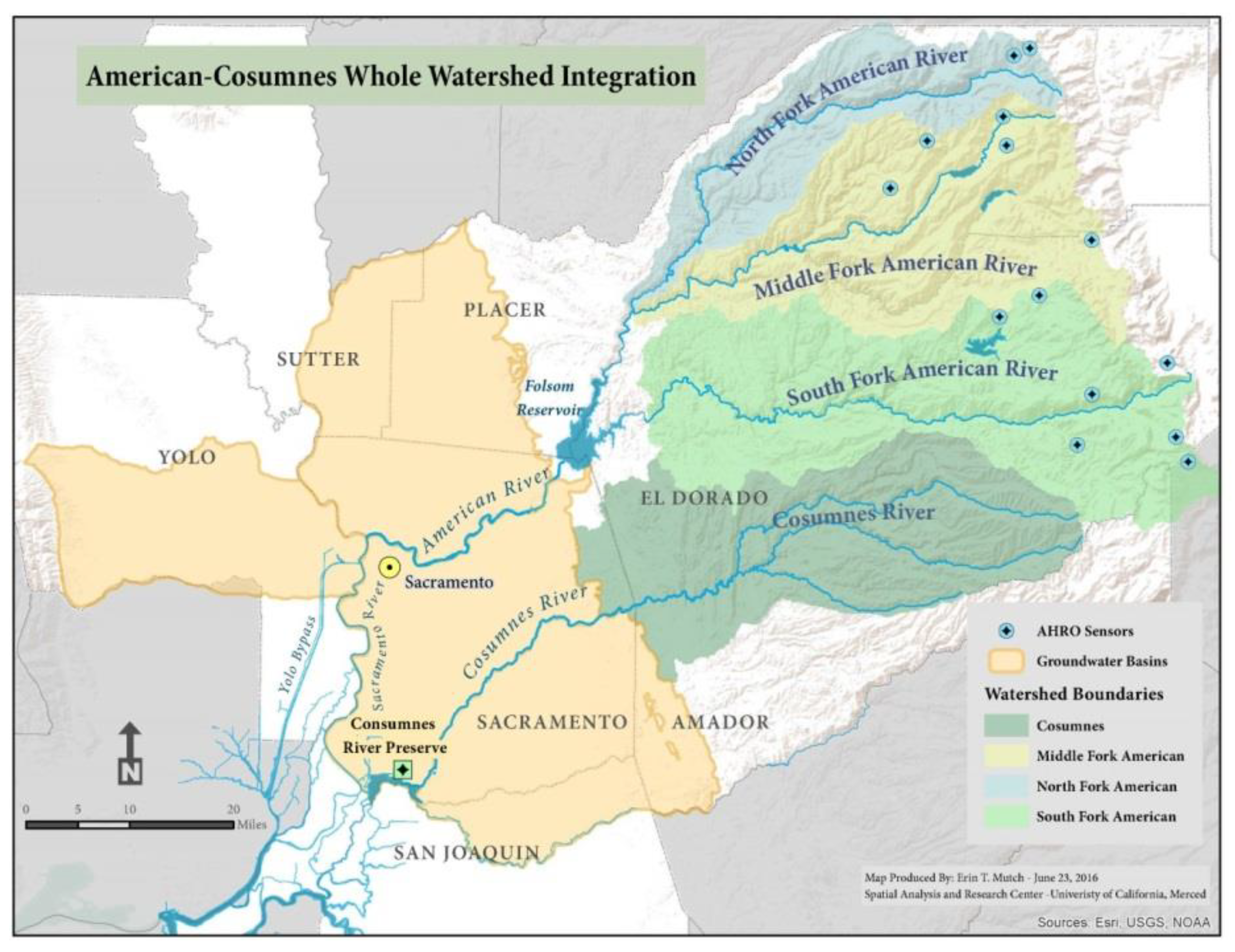


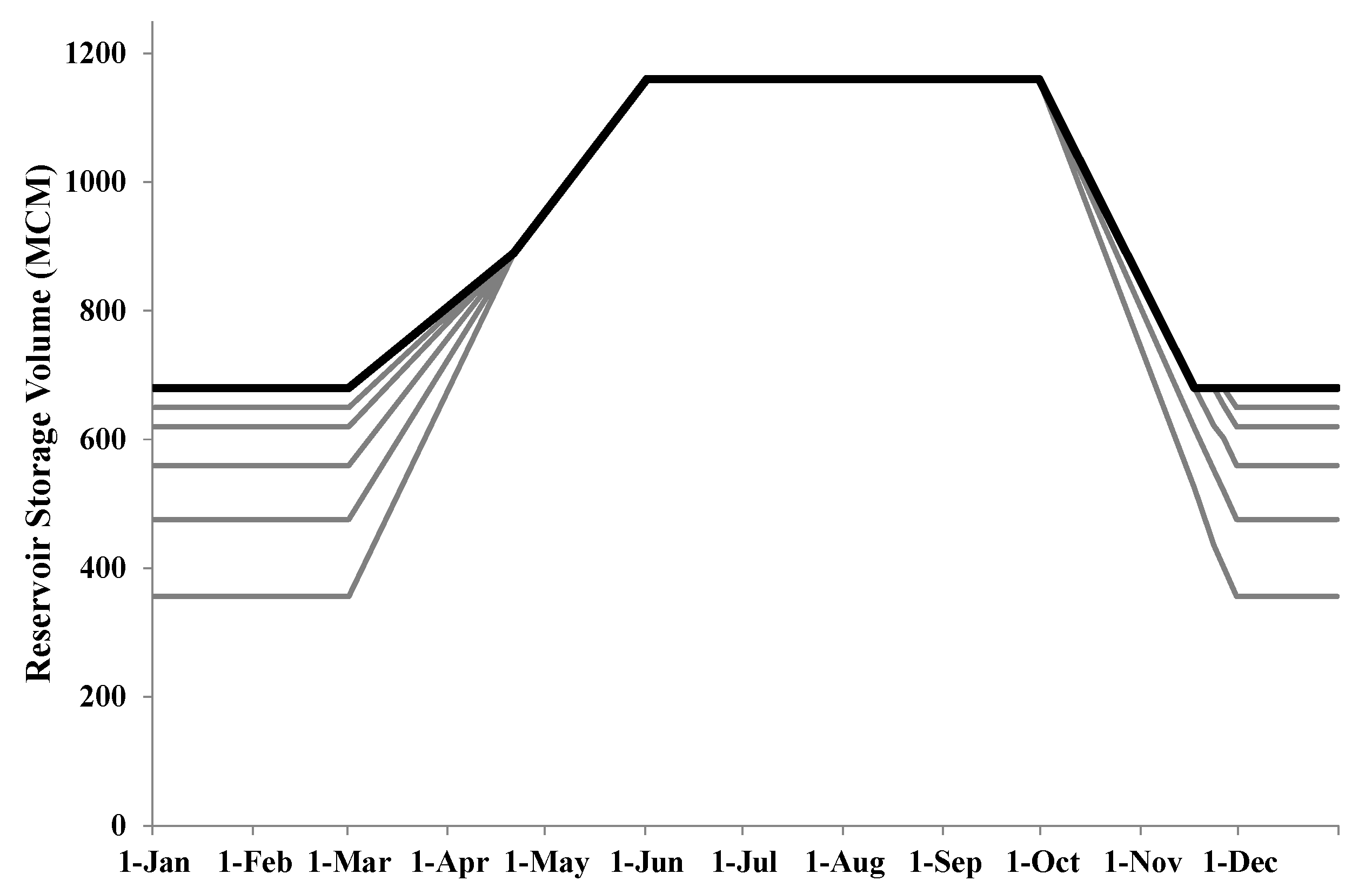
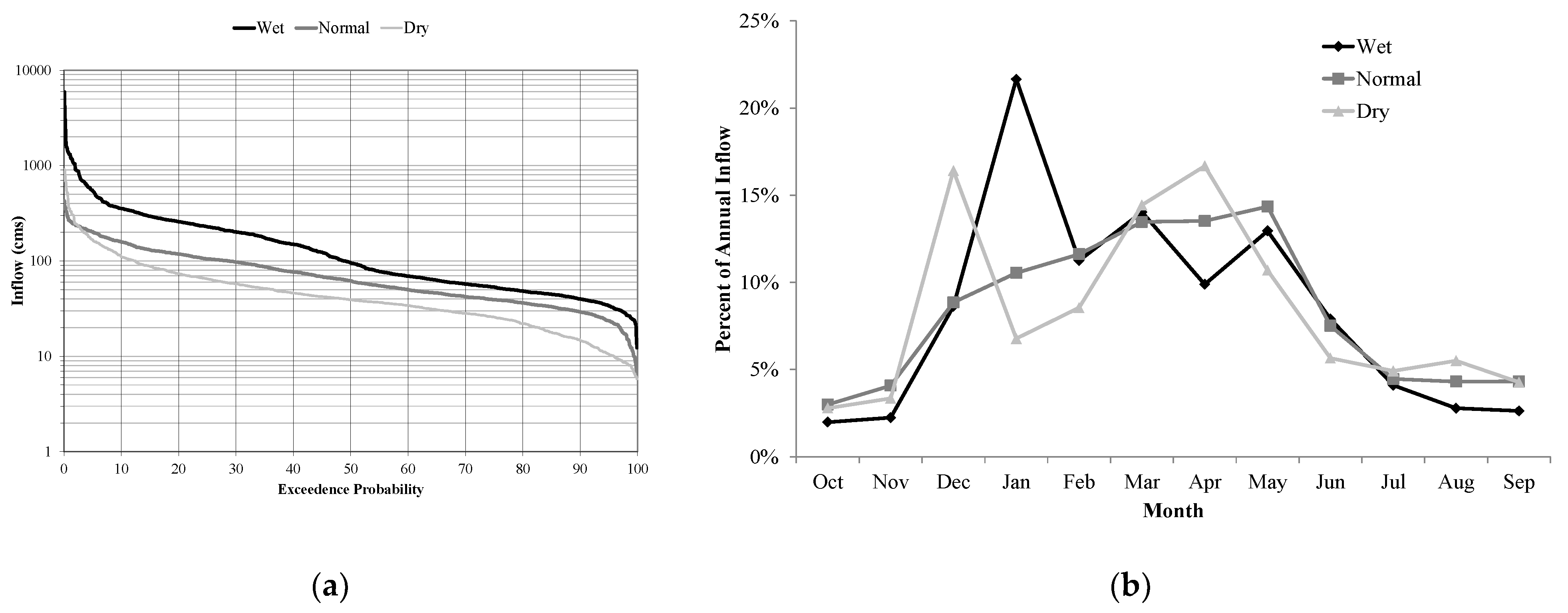
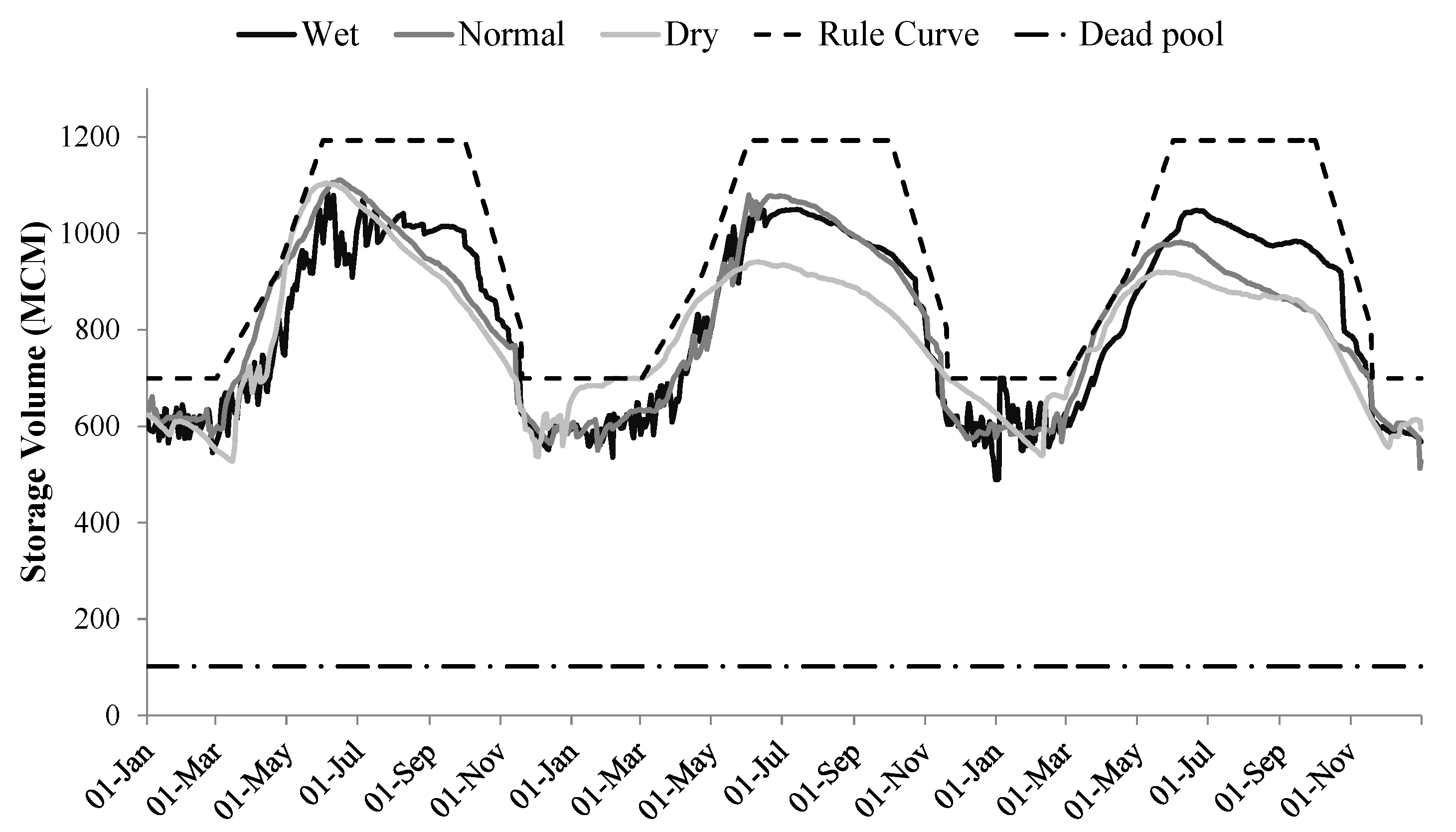

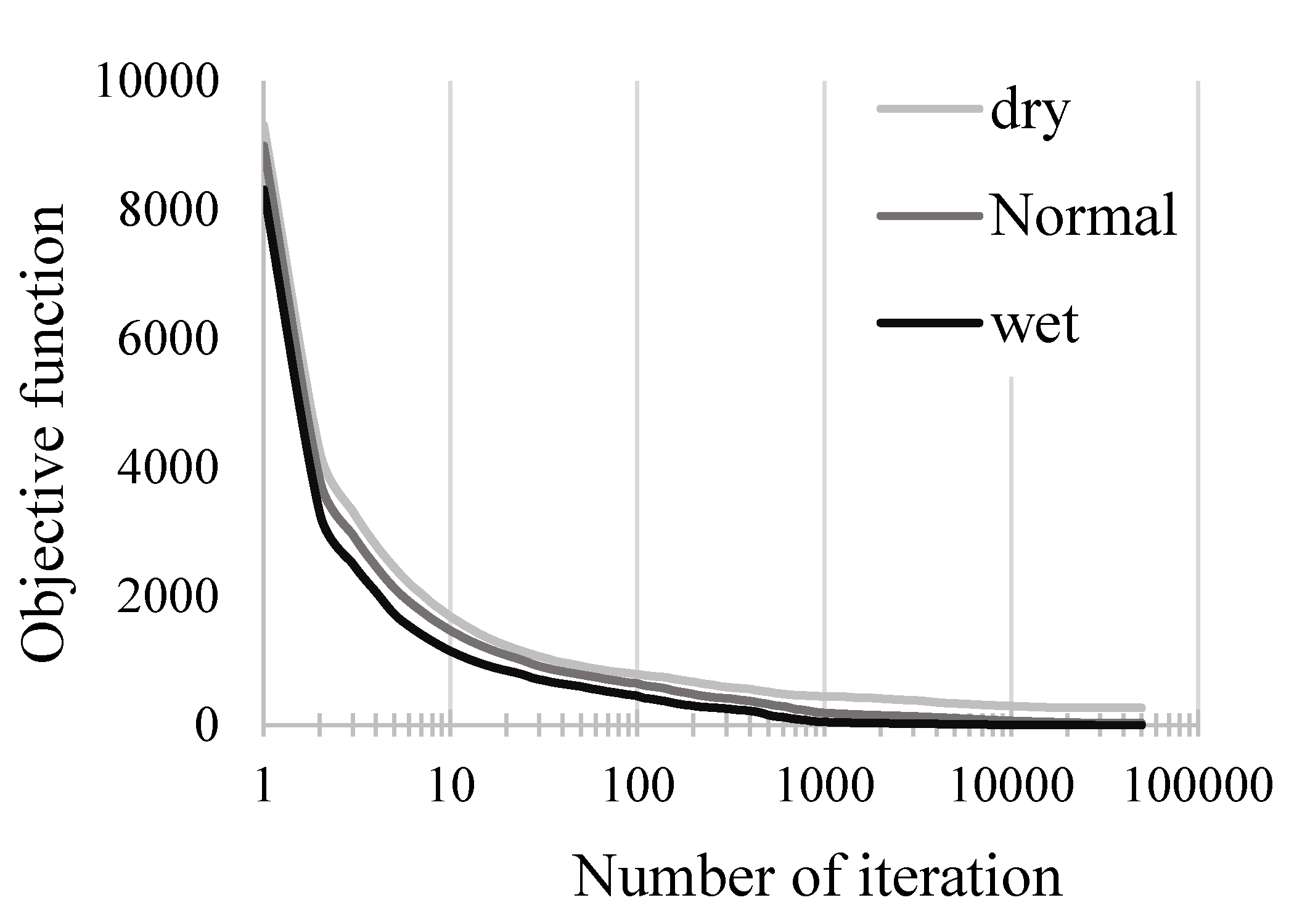

| Area | Elevation | Precipitation | Evapotranspiration |
|---|---|---|---|
| 4821 km2 (1861 sq mi) | 1473 m (4833 ft) | 1410 mm (55 in) | 633 mm (25 in) |
| Release Capacity | Elevation * (m msl) | Quantity | |
|---|---|---|---|
| Spillway | 16,055 cms @ 145 m | 127 m | 5 service gates 3 emergency spillways |
| Power penstocks | 226 cms | 93 m | Three power Penstocks |
| River outlets | 702 cms @ 127 m | Upper tier: 84 m Lower tier: 63 m | Two rows of four (Lower and upper tiers) |
| Total Inflow (MCM) | Total Release (MCM) | Storage (MCM) | Hydropower Generation (MW) | |
|---|---|---|---|---|
| Wet | 5817.90 | 5771.03 | 815.30 | 200.00 |
| Normal | 2532.34 | 2489.87 | 812.41 | 192.26 |
| Dry | 1849.80 | 1793.98 | 793.13 | 151.23 |
| Objective Function | Number of Iterations/Generations to Achieve Feasible Solution | Run Time (Seconds) | ||||
|---|---|---|---|---|---|---|
| Climate condition | CeA | GA | CeA | GA | CeA | GA |
| Wet | 0.04 | 50.8 | 1156 | 52,114 | 1032 | 52,114 |
| Normal | 33.6 | - | 4927 | 78,629 | 955 | 78,629 |
| Dry | 268.9 | - | 15,355 | 105,994 | 970 | 105,994 |
Publisher’s Note: MDPI stays neutral with regard to jurisdictional claims in published maps and institutional affiliations. |
© 2021 by the authors. Licensee MDPI, Basel, Switzerland. This article is an open access article distributed under the terms and conditions of the Creative Commons Attribution (CC BY) license (https://creativecommons.org/licenses/by/4.0/).
Share and Cite
Goharian, E.; Azizipour, M.; Sandoval-Solis, S.; Fogg, G. Using Cellular Automata Approach to Optimize the Hydropower Reservoir Operation of Folsom Dam. Water 2021, 13, 1851. https://doi.org/10.3390/w13131851
Goharian E, Azizipour M, Sandoval-Solis S, Fogg G. Using Cellular Automata Approach to Optimize the Hydropower Reservoir Operation of Folsom Dam. Water. 2021; 13(13):1851. https://doi.org/10.3390/w13131851
Chicago/Turabian StyleGoharian, Erfan, Mohammad Azizipour, Samuel Sandoval-Solis, and Graham Fogg. 2021. "Using Cellular Automata Approach to Optimize the Hydropower Reservoir Operation of Folsom Dam" Water 13, no. 13: 1851. https://doi.org/10.3390/w13131851
APA StyleGoharian, E., Azizipour, M., Sandoval-Solis, S., & Fogg, G. (2021). Using Cellular Automata Approach to Optimize the Hydropower Reservoir Operation of Folsom Dam. Water, 13(13), 1851. https://doi.org/10.3390/w13131851






